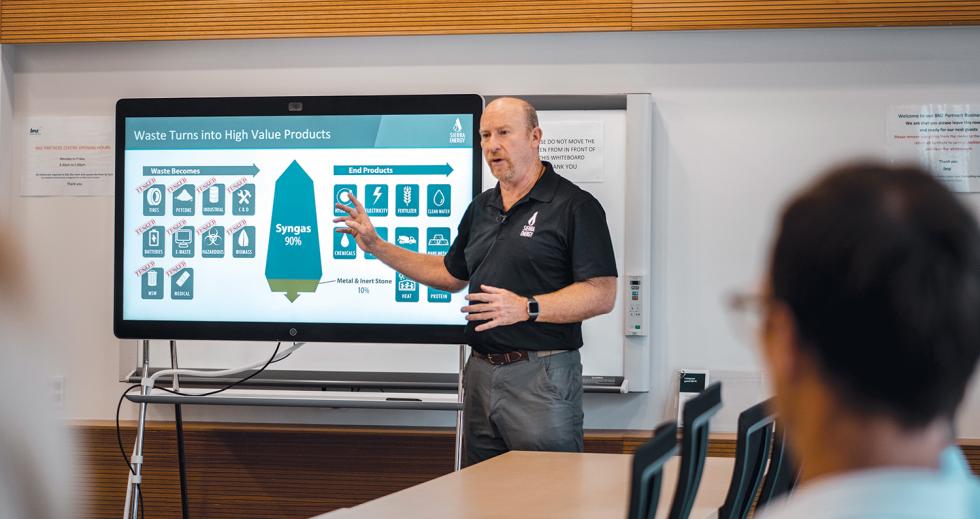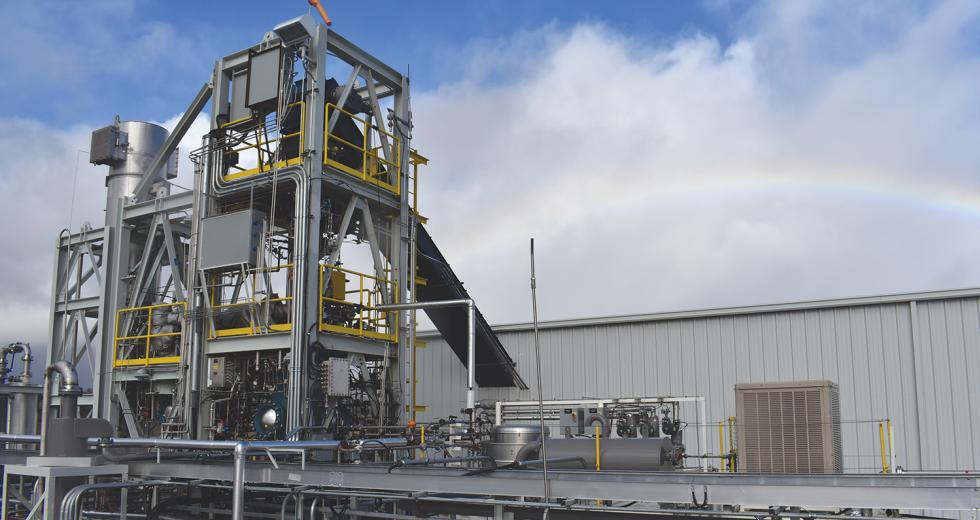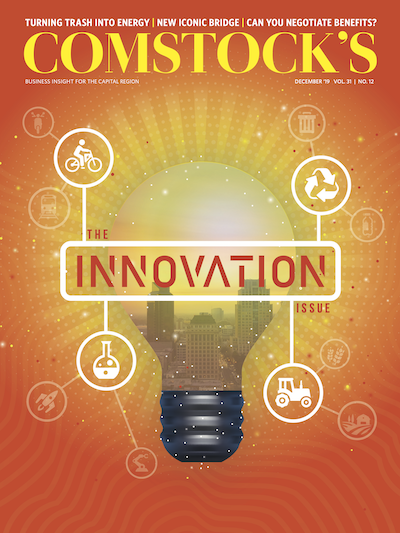Every year, the United States generates around 260 million tons of trash. And we don’t know what to do with it. As every good environmentalist knows, we’re in something of a recycling crisis: China no longer accepts our unsorted waste, recycling centers are shuttering, and the bulk of our mixed plastics end up in the sea or in landfills, which ooze methane and accelerate global warming.
At times we think we’re recycling, but we’re not. “Recycling is not what you do when you’re standing over your curbside collection bin. That’s not recycling,” says Mark Murray, executive director of Californians Against Waste, a nonprofit organization based in Sacramento. “That’s sorting. That’s segregating. And all of that material gets sorted into different piles of stuff.” He explains that when you put something in the blue bin, all you’ve done is sort it from your trash; it doesn’t truly get recycled unless someone eventually uses it to make a new product.
Much of what goes in that blue bin, like clean glass and clean paper and steel and aluminum cans, is still being recycled in California. Then there’s the mixed plastics, plastics 3-7, things like yogurt cups, plastic bags and plastic containers. Almost no one wants this stuff.
No one, that is, except serial entrepreneur Mike Hart, the CEO of Davis-based Sierra Energy. For the past 15 years, Sierra Energy has been developing a technology, FastOx gasification, that offers a tantalizing promise: convert trash to energy — with no pollutants. And not just some trash but all trash — scraps of wood, sewage sludge, car tires, even mixed plastic.
Sierra Energy only has one customer, but it’s a whale: the U.S. Department of Defense, which has hired the company to convert an Army base’s trash into energy. The testing starts in January 2020. If it works, if, theoretically, FastOx can reach mainstream adoption and the nation’s garbage is instead gasified with FastOx, Sierra Energy claims that in terms of lowering greenhouse gas emissions, this would have the same effect as taking 50 percent of the nation’s 276 million cars off the road, help wean us from fossil fuels, and power 15 million homes. This isn’t just a pipe dream; Hart now has the backing of a $1 billion investment coalition that has invested $33 million into his company.
And it all started with some tacky Hawaiian shirts.
From ‘Mai-Ties’ to Big Bang
Hart started young. He says when he was a kid, he launched a business that performed basic chores like dog walking, mowing lawns and pet sitting. He passed out handwritten brochures that said, “Do you want someone murdered? If so, don’t call us. But for anything else …” Thus, began a lifetime of entrepreneurship.
While studying political science at UC Davis, for example, Hart liked to wear Hawaiian shirts. But when he got his first real job at a real-estate company and was forced to wear a suit and tie, as a cheeky protest, he sliced up a Hawaiian shirt and fashioned the pieces into a tie. Inspired, in 1986 he started a company that sold these novelties: Mai-Tie. “We were making tens of thousands of ties,” he says, adding they were even worn by tech gurus like Bill Atkinson, the guy who invented the hyperlink. (Atkinson even gave the garish ties a slogan: “The tie that blinds.”)
“We don’t burn. We’re not burning. You’re not burning trash, you’re turning trash into a base molecule that you can do something with.” Michael Kleist, Vice President of Business Development and Marketing, Sierra Energy
Steve Wozniak wore a Mai-Tie. Hart knows this because he worked with Wozniak, along with Steve Jobs, as a consultant in the 1980s. Hart also consulted for NASA and the Department of Defense. A gifted software developer, he created an algorithm that, for one DOD process, shortened the computation time from three months (on their mainframe computers) to something that he says “could be done in a single afternoon.” He offered DOD officials the program for $1,000 a copy. They weren’t interested. “Then I raised the price to $25,000 a copy, and they sold like hotcakes.”
By 2001, Hart owned the historic Sierra Railroad, and during the power crisis in California, in the midst of a rolling blackout, he was in the locomotive’s engine house in Oakdale. Something occurred to him: The lights are out, but the engine is still running. Locomotives don’t need electricity. Could locomotives help power the city? Hart took 48 locomotives to McClellan Park, signed a contract with the State of California and worked on hooking them into the power grid.
Nothing came of this arrangement, but it did get him thinking about energy. In a stroke of good fortune, in 2003, he was a judge at the UC Davis Big Bang Business Competition. One student pitched a provocative idea: What if you take blast furnaces that are used in the steel industry, inject oxygen, and then use them to break down anything into a synthetic gas, without causing pollution? The student, Chris Kasten, was a grandson of an engineer at Kaiser Steel who first had the idea. Grandfather passed it to grandson, who, along with the help of adviser Chris Soderquist (the founder of business incubator Venture Lab), then pitched it at UC Davis. Immediately, Hart was intrigued.
He bought the patents in exchange for stock in the company. Sierra Energy was born.
For several years, Hart struggled to transform the theoretical concept into concrete proof. What he describes as a “grim time” includes failed attempts to use experimental blast furnaces in Sweden and steel companies in China. In 2009, a breakthrough: Sierra Energy began building testing systems at the Army’s Renewable Energy Testing Center at McClellan, and since has been testing progressively larger proof of concepts.
Extraordinary Claims — and Evidence
Gasification is not new. Bryan Jenkins, a professor in UC Davis’ Biological and Agricultural Engineering department, notes that it’s a “fairly old technology,” even used in World War II by both the Axis powers and the Allies because petroleum was in short supply. They gasified wooden blocks and charcoal to power their vehicles. “It was a very difficult thing to do, and it required a lot of energy and maintenance, but the vehicles did run,” Jenkins says. In South Africa, because of years of apartheid-era oil embargoes, gasifiers converted coal into gasoline. And even trash-to-energy is a fairly old trick, although not as common in the U.S.; countries such as Sweden, Japan and Finland are actively burning trash. In Sweden, roughly half of all trash is recycled, the other half converted to energy.
Yet Sierra Energy offers a new twist: FastOx gasification. Like with a traditional furnace, waste is burned and converted to energy. Unlike a traditional furnace, the system is injected with oxygen and superheated to 4,000 degrees, which breaks down the waste at a molecular level. “We don’t burn. We’re not burning,” says Michael Kleist, Sierra Energy’s vice president of business development and marketing, adding that people often mistakenly confuse FastOx with incineration. “You’re not burning trash, you’re turning trash into a base molecule that you can do something with.”
There are only two outputs. Organic waste (like banana peels) turns into synthetic gas, and inorganic waste (yogurt cups) melts into either liquid or solid stones, which can then be used to make things like concrete, road base or bricks. Just as important as the two outputs are the lack of outputs — no emissions of dioxins, furans or the kind of pollutants resulting from incineration. FastOx gasification is clean.
Mike Hart, the chief executive officer of Sierra Energy. (Photo
courtesy of Sierra Energy)

Synthetic gas is useful. This “syngas” can be transformed into almost anything — natural gas, virgin plastic, ethanol or just plain electricity. The FastOx system is powered by its inputs, whether those inputs are plastic packaging, rotted chicken or a print copy of Comstock’s. Remember the end of “Back to the Future,” when Doc Brown opens what appears to be the gas tank of the DeLorean and dumps in some banana peels and beer cans? That’s no longer sci-fi. Instead of sending our waste on a barge to China, it can be converted to electricity here at home.
FastOx isn’t cheap. The capital investment for Sierra Energy’s flagship product, the Pathfinder, is in the neighborhood of $10 million to $20 million. Over time, those capital costs will be recouped, the company says, by income streams from the sales of electricity (made from the syngas), carbon credits, inert stones (generated by the gasifier) and tipping fees. The logic is similar to how a homeowner might purchase solar panels, hoping they pay for themselves within a few years. Sierra Energy claims a $15 million Pathfinder — which can gobble up 50 metric tons of trash per day — would handle the waste of a community of 50,000 people, yield annual profits of $3 million and supply a 20 percent rate of return. In other words, Sierra Energy is not counting on people to use this technology out of the goodness of their hearts. “Changing the world overnight needs to have a profit incentive,” says Hart. “People are (interested in FastOx) because it’s profitable. Not because, ‘Oh wow, this would be a great thing to do!’”
Sierra Energy’s website has a calculator to help potential customers (municipalities, waste handlers and entrepreneurs) determine if it makes sense to buy a FastOx system. Sometimes it doesn’t. The Pathfinder provides the most benefits for communities where the cost of both electricity and landfilling is high. So in some states in the Southeast, thanks to cheap energy from nuclear power and a low cost of landfills, the FastOx would be a losing bet. But Hart says in the “overwhelming majority” of cases switching to FastOx will be profitable. (Presumably, there would also be the pragmatic questions of how to sell the energy on the grid, how to sell the stones and so on.)
In theory, FastOx can solve our recycling problem, fight global warming, reduce dependence on fossil fuels and provide customers a 20 percent return on investment.
Sound too good to be true?
Hart knows it does. “It’s too good to be true!” he says in jest, laughing a bit, adding that his team has heard that expression every step of the way, from theoretical equations to experimental prototypes. Potential investors and customers all say the same thing: It’s too good to be true.
Not the Best Solution for All Waste
Not even Sierra Energy views its system as the best solution for all waste. While it says the Pathfinder is capable of turning any kind of garbage into energy — without sorting — some is more efficient than others. “There are some things I’d rather not deal with,” Hart says. For example, FastOx melts metals into … metals. That is less efficient than typical recycling. Same with clean glass and clean paper. “To the extent that you can recycle, you should,” says Hart. “I believe that people should recycle whatever makes economic sense.”
Murray, of Californians Against Waste, agrees. He pushes back on the idea that recycling is dead. “The fact is that most of the materials we’ve been collecting for recycling for the last 30 years continue to have end-use markets and continue to be recycled,” he says, adding that clean paper, glass and aluminum cans are still being recycled. (Do we need to “clean” our recycling? Murray reassures that “washing glass and plastic containers before recycling is not necessary, though some effort to ‘empty’ is appreciated,” and that “a small amount of grease on a pizza box is not going to be an issue.”)
“Changing the world overnight needs to have a profit incentive. People are (interested in FastOx) because it’s profitable. Not because, ‘Oh wow, this would be a great thing to do!’” Mike Hart, Chief Executive Officer, Sierra Energy
But things get tricky with plastics. It’s the category 3-7 plastics — again, the yogurt cups — that are being rejected by both China and recycling centers. And the kind of waste that can fuel the Pathfinder. So Sierra Energy does not intend to replace recycling, but to pick up the slack for the hard-to-recycle materials that have anemic end markets.
Stephen Kaffka, the director of the California Biomass Collaborative at UC Davis, has studied gasification extensively. “It looks very solid in its design, the concepts are well-articulated,” he says of Sierra Energy’s FastOx, but he cautions that first-of-kind technologies often need “a lot of hand-holding and subsidization in their early stages.” He adds that of the other gasifying systems in use for any long stretch of time, “I’m not sure that any of them have operated at a profitable level.” Yet he acknowledges that if Sierra Energy can do what it claims, then “they’re probably going to be a very successful company and have a big role to play.” He has just one key question. “I would ask them this: Is it working?”
We’ll soon find out. Ever since Hart scooped up the patents, Sierra Energy has focused on trying to prove the madcap idea actually works, and can work at scale. Backers include the California Energy Commission (awarding a $5 million grant in 2012) and the DOD, which provided a $3 million investment and the opportunity to build a working Pathfinder at Fort Hunter Liggett, a forward-thinking Army base in Monterey County that has an ambitious goal of zero waste and net-zero energy.
Everything hinges, it seems, on what happens at Fort Hunter Liggett. Millions — and quite possibly billions — are at stake.
In July, the company raised $33 million in Series A funding, anchored by Cox Enterprises and Breakthrough Energy Ventures, the $1 billion investment coalition that includes George Soros, Mark Zuckerberg, Bill Gates and Richard Branson. Breakthrough’s involvement gives Sierra Emergy a jolt of instant enviro-cred; it only invests in technologies “with the potential to reduce at least half a gigaton of greenhouse gases every year,” according to the fund’s website.
The purpose of the capital is to operate a fully functioning system at Fort Hunter Liggett for the bulk of 2020, with a goal of successfully running it for 1,000 hours. “The system itself works,” says Hart. “But we have to staff up for around-the-clock operations.” (FastOx is not intended to power all of the base, but rather serve as one slice of the power pie, along with others such as solar and battery energy storage.)
According to Sierra Energy, it has been contacted by 9,000 potential customers. (The queries jumped after a 2013 profile in The New York Times.) Yet virtually all are taking a wait-and-see approach: Does it work? If the system can hit the 1,000-hour threshold, says Hart, a first wave of dozens of customers will purchase a Pathfinder. But the majority still will want more proof: But does it really work? If it can spit out energy for 2,500 hours, then that opens the door for hundreds of additional customers, Hart says, and once FastOx runs for a year, that opens the door to a thousand additional customers, he says. For some quick perspective, theoretically, if Sierra Energy can indeed land 1,000 customers, given the Pathfinder costs $15 million each, that would imply gross revenues of $15 billion. Those two key words again: theoretically and if.
Hart gets it. He knows people are skeptical and that they should be skeptical. “People need proof,” he says. “It’s not enough to simply say, ‘Here’s experimental data. Here’s our initial run.’ That’s not enough.” He’s reminded of Carl Sagan, who once said, “Extraordinary claims require extraordinary evidence.” Hart acknowledges that, “When you say, ‘Hey, I solved the world’s waste problems,’ people are really going to want the proof.”
Editor’s note: A sentence has been abridged from an earlier version to correct an error in the print version of this story.
—
Get this and other stories delivered to your inbox weekly: Sign up for our free email newsletters by clicking or tapping here.




